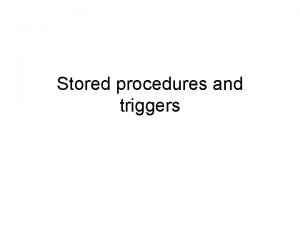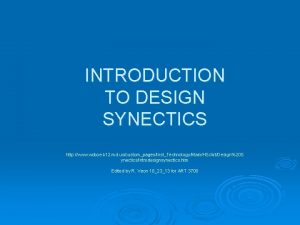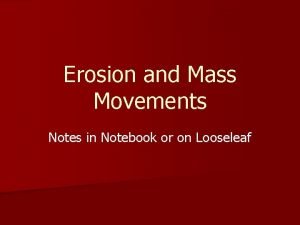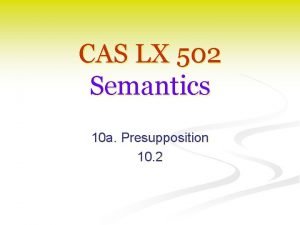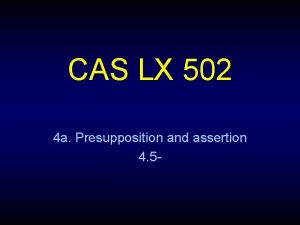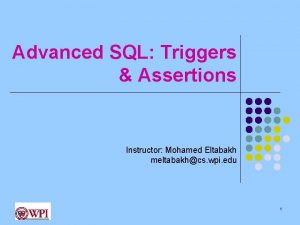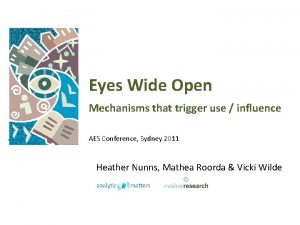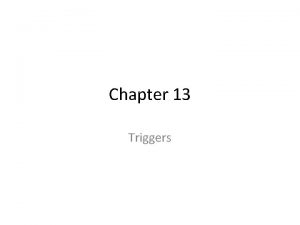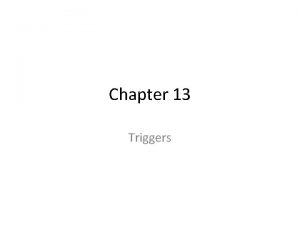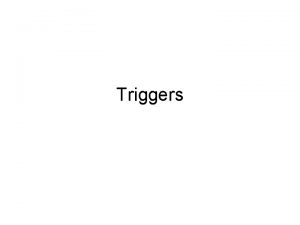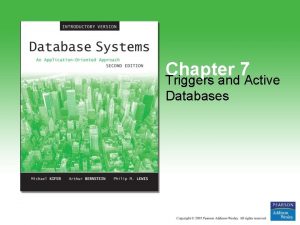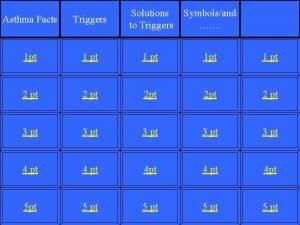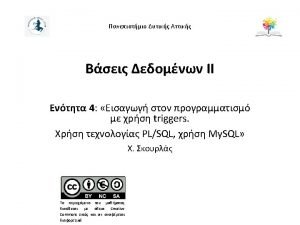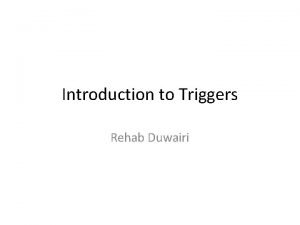Chapter 13 Triggers Trigger Overview A trigger is













- Slides: 13

Chapter 13 Triggers

Trigger Overview • A trigger is a program unit that is executed (fired) due to an event • Event such as updating tables, deleting data or inserting data to a table • By defining one or more triggers on a table, you can specify which data-modification actions will cause the trigger to fire. • The trigger is never invoked unless the specified action is taken • For example, an insert trigger is fired when the INSERT statement is executed against the specified table.

Trigger Overview • Although a trigger is a schema object, separate from table objects, it can be associated with only one table, which you specify when you create your trigger definition • When the applicable data modification statement is invoked against that table, the trigger fires; however, it will not fire if a similar statement is invoked against a different table

Create SQL Triggers • CREATE TRIGGER <trigger name> { BEFORE | AFTER } { INSERT | DELETE | UPDATE [ OF <column list> ] } ON <table name> [ REFERENCING <alias options> ] [ FOR EACH { ROW | STATEMENT } ] [ WHEN ( <search condition> ) ] <triggered SQL statements>

Create SQL Triggers • In the second line, you must designate whether the trigger is invoked before or after the data modification statement is applied to the subject table • In the third line of syntax, you specify whether the trigger is an insert, delete, or update trigger. If it is an update trigger, you have the option of applying the trigger to one or more specific columns. If more than one column is specified, you must separate the column names with commas

Referencing Old and New Values • The purpose of this clause is to allow you to define correlation names for the rows stored in the transition tables or for the transition tables as a whole. • The aliases can then be used in the triggered SQL statements to refer back to the data that is being held in the transition tables • This can be particularly handy when trying to modify data in a second table based on the data modified in the subject table.

Referencing Old and New Values • SQL supports four options for this clause: – REFERENCING OLD [ROW] [AS] <alias> – REFERENCING NEW [ROW] [AS] <alias> – REFERENCING OLD TABLE [AS] <alias> – REFERENCING NEW TABLE [AS] <alias> • Notice that, in the first two options, the ROW keyword is not mandatory. If you don’t specify ROW, it is assumed

Referencing Old and New Values • you cannot include more than one of any single type. For example, you cannot include two OLD ROW options in your trigger definition • You cannot use the NEW ROW and NEW TABLE options for delete triggers because no new data is created. • You cannot use the OLD ROW and OLD TABLE options for insert triggers because no old data exists. • You can use all four options in an update trigger because there is old data and new data when you update a table. • You can use the OLD ROW and NEW ROW options only when you specify the FOR EACH ROW clause in the trigger definition.

Create SQL Triggers • syntax contains the FOR EACH clause, which includes two options: ROW or STATEMENT. – If you specify ROW, the trigger is invoked each time a row is inserted, updated, or deleted. – If you specify STATEMENT, the trigger is invoked only one time for each applicable data modification statement that is executed, no matter how many rows are affected. • If you do not include this clause in your trigger definition, the STATEMENT option is assumed, and the trigger fires only once for each statement.

The WHEN Clause • The WHEN clause allows you to define a search condition that limits the scope of when the trigger is invoked. The WHEN clause is similar to the WHERE clause of a SELECT statement. You specify one or more predicates that define a search condition. • If the WHEN clause evaluates to true, the trigger fires; otherwise, notrigger action is taken

Example • CREATE TRIGGER countries_lacations AFTER INSERT ON countries REFERENCING NEW ROW AS new FOR EACH ROW BEGIN insert into locations( Country_ID) VALUES ( new. country_id); END; Note: The previous example will produce error because it didn’t insert a value in the primary key (location_id) in Locations table

Example • CREATE TRIGGER UPDATE_TITLE_COSTS AFTER Delete ON employees REFERENCING OLD ROW AS old FOR EACH ROW BEGIN Insert into Job_History (Employee_id, job_id, Department_id) Values( old. employee_id, old. job_id, old. department_id); END;

Dropping a trigger • DROP Trigger trigger name
 Triggers and routines in sql
Triggers and routines in sql Seeking safety coping with triggers
Seeking safety coping with triggers Triggers of mass movement
Triggers of mass movement Presupposition examples sentences
Presupposition examples sentences Synectic trigger mechanisms art
Synectic trigger mechanisms art Mass movement
Mass movement Potential presupposition
Potential presupposition Presupposition triggers
Presupposition triggers Synectics art
Synectics art Art synectics examples
Art synectics examples Rage cycle
Rage cycle Triggers and assertions
Triggers and assertions Mudflow definition geography
Mudflow definition geography Wide open trigger review
Wide open trigger review
